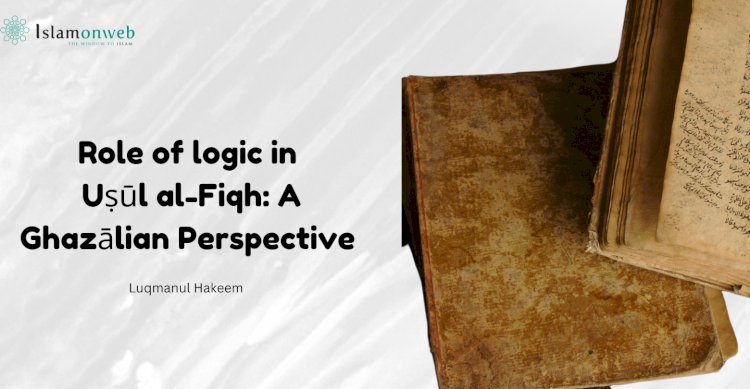Role of logic in Uṣūl al-Fiqh: A Ghazālian Perspective
The intellectual landscape of medieval disciplines, especially in the Islamic world, thrived on interdisciplinary exchanges, fostered by polymath scholars. Within the realm of ʾUṣūl al-Fiqh, scholars such as Imam al-Ghazālī, Ibn Ḥazm, and Fakhr al-Din al-Razi played pivotal roles, shaping the discourse and contributing to the synthesis of diverse intellectual traditions. ʾUṣūl al-Fiqh, the field of Principles of Jurisprudence, witnessed the engagement of two prominent styles:
Ṭarīqatul Fuqaha (the style of jurists) and Ṭarīqat al-Mutakallimīn (the style of theologians)1. Among these, the latter exerted significant influence on the exchange between logic and jurisprudence.
Logical Foundations in ʾUṣūl al-Fiqh
Imam al-Ghazālī, in his seminal work Mustaṣfa fī ʿIlm al-ʾUṣūl, proclaimed the indispensability of logic by stating, "Whoever does not know it has no credibility in his knowledge at all."2 This sentiment found resonance in later scholars like Imam Taj al-Dīn al-Subuki, underscoring the pivotal role of logic as one of the most useful sciences and the most useful in all research in his Rafʿ al-Hajib ʿalā Muḥtaṣar Ibnu Ḥājib.
The Andalusian scholar, Ibn Ḥazm al-Andalusi, marked a significant milestone by being the first religious scholar to delve into logic with his work Al-Taqrīb li-Haddi al-Mantiq. However, his contributions faced limited reception due to the geographical distance between Andalusia and the Islamic mainland, illustrating the challenges of disseminating knowledge in medieval times.3
In contrast to Stoics who regarded logic as a subset of philosophy, Mutakallimīn, the theologians, considered it a tool for purifying thought processes, aligning more with the peripatetic tradition.4 ʾUṣūli works traditionally initiate with comprehensive introductions, addressing terminology, theological stances, and the semantics of the Arabic language.
These introductions delve into the fundamental concepts of knowledge and ignorance (ilm, jahl), exploring variations like speculation, doubt and false impression (wam). The categorization of knowledge into axiomatic and acquired knowledge is also discussed in the introductions of ʾUṣūli works.5 Scholars, such as Imam Jalal al-Din al-Mahalli, provide insightful commentaries on the works of predecessors, offering analyses of the five arts.6 In his commentary on Imam al-Subuki's Jam' Jawāmi', Imam al-Mahalli sheds light on imaginary and fundamental propositions, contributing to the broader understanding of logical structures within ʾUṣūl al-Fiqh.
Linguistic discussions in ʾUṣūl al-Fiqh further contribute to the integration of logic, classifying terms into coincidental (Muṭābaqa), partial (Taḍammun), and associative (Iltizām).7 Noteworthy scholars like Imam al-Razi distinguish terms into universals and particulars, unraveling nuanced essential and accidental universals. ʾUṣūli scholars adopt a comprehensive and exclusive approach in defining concepts. For instance, the term (hadd) is defined with genus and differentia, while (rasm) is described with specific differences (al-khāssa),8 examples, or divisions, enriching the precision and clarity of legal terminology.
Integration of Logic in ʾUṣūl al-Fiqh
ʾUṣūli scholars incorporate various logical methods into jurisprudential reasoning. Imam al-Shafi's use of induction (istiqra) to determine the durations of menstruation is a well-known example. Imam Abu Bakr al-Baqillāni validates the enumeration method (Sabr wa Taqsīm) for finding causes, and Burhān al-Khulf employs conjunctive conditional syllogisms (qiyas shartiyya muttasila) in logic.9 In Shifa al-Ghalīl, Imam al-Ghazālī introduces a unique type of demonstration, the demonstration of i'tilal, consisting of two premises and a conclusion, indicative of a syllogism.
In ʾUṣūl al-Fiqh, the analogy of indication mirrors the demonstration of the fact (burhān innī) in logic, where the cause is derived from the effect. Conversely, the analogy of the cause aligns with the demonstration of the reasoned fact (burhān limmī), asserting that the ruling emanates from the cause. These analogies are essential in deriving legal maxims, exemplified by principles such as10:
- If the basis falls, the division falls.
- Doubt about the condition necessitates doubt about the conditioned.
- What is indivisible; the ruling on some of it is the same as the ruling on all of it.
Imam al-Ghazālī 's Admiration for Greek Logic
Imam al-Ghazālī employed the logical foundations to construct the science of jurisprudence. The following three points worked as core to this interplay between the disciplines11.
- Imam al-Ghazālī ’s admiration for the Aristotelian and Stoic logical approach to the extent of belief in it.
- Imam al-Ghazālī adopted Greek logic as an approach through which he may have formulated a scientific method with his own conceptual and cognitive structure.
- Employing logic with its Greek metaphysics in the science of the principles of jurisprudence will bring Imam al-Ghazālī before two contradictory cultures; either he adapts this mixture by following a specific strategy, respecting the specificities of the science of the principles of jurisprudence, or his project is doomed to failure.
Imam al-Ghazālī 's Unique Perspective
In his Mi'yār al-‘Ilm and Shifa al-Ghalīl, Imam al-Ghazālī posits that juristic and logical discussions are on the same level, with one complementing the other. He asserts that these realms do not contradict each other; instead, they exist harmoniously.12 According to him, theologians should actively engage with logic, emphasizing that this tool is not exclusive to philosophers; rather, it is a versatile instrument that can enhance understanding across various fields.
Furthermore, Imam al-Ghazālī challenges the nomenclature of the field, proposing alternative names more aligned with Islamic scholars and linguistic nuances. He suggests terms such as the Touchstone of Reasoning, the Criterion of Knowledge, The Correct Balance, and Standard.13 In the linguistic exploration, he compares terminologies across disciplines, including those of jurists, logicians, theologians, and grammarians, showcasing his commitment to finding terminology that resonates universally.
Delving into the origin of logic, Imam al-Ghazālī offers a unique standpoint rooted in his theological perspective. He redefines the First Teacher as Allah, the Second Teacher as Jibreel, and the Third Teacher as the Prophet.14 According to him, all demonstrations can be found in the Quran, asserting that the Greeks derived their knowledge from the leaflets of Ibrahim and Musa.15 This theological grounding underscores his belief in the divine origin of logical principles.
Imam al-Ghazālī 's fascination with the term 'mīzan' in the Quran serves as a pivotal aspect of his interpretation. He passionately interprets 'mīzan' as logic, finding resonance in verses such as "and with them We sent down the Scripture and the balance" (al-Hadid 25), "Weigh with an even balance" (al-Shu'ara 182), and "As for the sky, He raised it, and set the balance" (al-Rahman 7). These verses, according to Imam al-Ghazālī, signify the divine endorsement of the importance of balance and logic,16 further cementing his theological approach to the integration of logic in Islamic thought.
Dr. Taha Abdel Rahman sees the necessity of renewing the overlap between the two sciences, but in a way that is opposite to what was the case among the predecessors, and he sums up his claim by saying:17 “For our part, we see the necessity of renewing the links between logic and ʾUṣūl; If the predecessors, led by Imam al-Ghazālī , made logic an introduction to the ʾUṣūl al-Fiqh, then in the connection between the two sciences, we follow a path opposite to the path of those who did. We do not make logic a part of the ʾUṣūl al-Fiqh as they did, but rather we make the ʾUṣūl al-Fiqh a part of the science of logic. Among the concepts, approaches and rules of the ʾUṣūl are what falls under the section ‘natural logic’, such as types of semantics, and the section ‘argumentative logic’, such as types of objections, debate, and analogy, and what falls under the section ‘demonstrative logic’, such as types of legal rulings.
Imam al-Ghazālī 's legacy in ʾUṣūl al-Fiqh is marked by his profound integration of logical foundations. While challenging, his approach highlights the intricate connection between logic and jurisprudence, opening avenues for further exploration.
About the author
Luqmanul Hakeem is a graduate from Department of Civilizational Studies, Darul Huda Islamic University, Chemmad, India and lecturer at Islahul Uloom Arabic College, Tanur. His areas of interest include Islamic theology, Islamic legal theory, and science and religion.
Endnotes:
- Mohamed Hassan Hito, al-H̱ulaṣa fi ʾUṣul al-Fiqh, Darul Ziya, Kuwait, pp.10
- Abu Hamid al-Ghazali, al-Mustasfa min ‘Ilm al-Usul, Vol. 1, pp. 45
- Wael al-Harithi, ‘Alaqa 'Ilm al-Usul bi 'Ilm al-Mantiq, pp. 257
- pp. 69-70
- Mohamed Hassan Hito, al-H̱ulaṣa fi ʾUṣul al-Fiqh, pp. 25-32
- The five rational arts in logic are: Scientific demonstration, Dialectic, Sophistry, Rhetoric, and Poetry.
- Jalal al-Din al-Mahalli, Sharh al-Mahalli ‘Ala Jam’ al-Jawami’, pp. 35
- pp. 17-20
- Abu Bakr al-Baqillani, al-Taqrib wal Irshad by, Vol. 1, pp. 176-176, 199-200
- 'Abd al-Ghali al-Muttaqi, Tadakhul 'Ilm al-Mantiq Ma' 'Ilm Usul al-Fiqh, pp. 49-54
- Zain al-'Abidin Magribi, al-Usus al-Mantiqiyya li Usul al-Fiqh 'Inda Abi Hamid al-Ghazali, p. 37-46
- Abu Hamid al-Ghazali, Mi’yar al-‘Ilm, pp. 60
- Abu Hamid al-Ghazali, al-Qistas al-Musthaqim, pp. 41
- Ibid, pp. 15
- pp. 42
- pp. 14-15
- Muhammed Adiyy, al-Swilah Baina ‘Ilm al-Mantiq wa ‘Ilm Usul al-Fiqh
Reference:
Wael al-Harithi, ‘Alaqa 'Ilm al-Usul bi 'Ilm al-Mantiq, Beirut 2012
'Abd al-Ghali al-Muttaqi, Tadakhul 'Ilm al-Mantiq Ma' 'Ilm Usul al-Fiqh, 2016
Zain al-'Abidin Magribi, al-Usus al-Mantiqiyya li Usul al-Fiqh 'Inda Abi Hamid al-Ghazali, https://doi.org/10.4000/insaniyat.936
Abu Hamid al-Ghazali, al-Qistas al-Musthaqim,
Disclaimer
The views expressed in this article are the author’s own and do not necessarily mirror Islamonweb’s editorial stance.
























Leave A Comment